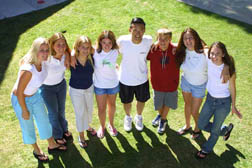 Asking yourself or group these questions can be the best way to decide which fundraiser is right for you!
Asking yourself or group these questions can be the best way to decide which fundraiser is right for you!
When do you want to start your fundraiser?
Start planning at least 1 month before you want to begin. If you need to start immediately please consider that some products may take longer to get than time allows. Other fundraisers are easy to get quickly if necessary. If you plan ahead then you can choose the best fundraiser for you.
How much time do you have to sell?
We recommend a selling period of about 2 weeks including 2 weekends for most fundraisers. Allow time for late orders to be turned in after your deadline date.
How much money do you want to raise?
You need to have a goal. This helps you plan how much each participant must sell to reach your goal. Consider the profit potential.
 How many participants will you have?
How many participants will you have?
Do you have 10 kids or 1000 kids? Divide your goal by the number of participants to see how much each child will have to sell to reach your goal. A fundraiser with a higher selling price will need fewer items sold per person. Most order taking fundraising small groups (20-30) can expect average sales of $100-$150 per person. Large groups (over 200) can expect average sales of $80-$120 per person (approx. 1/2 of group will participate). Not all kids will participate in every group unless it is mandatory and some kids will sell lots of items, while others will only sell a few. See if the average sale is reasonable to attain your goal.
When do you need the funds?
If you need the money right away then you will need to collect while you take orders or sell. This also applies if you think you will have problems collecting money later on. However, if you can collect when you deliver, your sales will usually be higher than collecting upfront.
 Do you want to take orders or sell items in-hand?
Do you want to take orders or sell items in-hand?
Pre-sell fundraisers normally have a higher selling price and total dollars sold per person. They do require taking orders, possibly tallying or sorting orders, and scheduling delivery after the sale. With in-hand fundraisers you must carry the product with you to make the sales. However, purchases are on the spot and have no need for collection or delivery.
Do you have space for inventory?
Some fundraisers require space to sort items or store them while they are being sold. Other fundraisers are perishable and need to be kept cool or refrigerated if not distributed immediately.
Do you have a volunteer base to help organize and run the fundraiser?
Extra volunteers are a must with any fundraiser. Dividing up the work helps things go smoothly and is less stressful.
 Can your students carry home the products or will parents need to assist?
Can your students carry home the products or will parents need to assist?
Fundraising products that are heavy or bulky need parents to help move items from place to place. A letter to parents reminding them of delivery day will help insure their availability to help.
What fundraisers have you done before?
If you sold something before that bombed, maybe you need to try something else. Likewise, what sold well in your community before should sell well again.
What fundraisers are other groups in your area doing?
If everyone else is already selling one fundraising option, try selling another fundraising option. People will appreciate the choice and be more likely to buy.
 What fundraiser are your kids or parents most excited about?
What fundraiser are your kids or parents most excited about?
If they are excited about the product then they will sell it a lot easier. Listen to what your group has to say about the fundraising options. Trying to push a fundraiser on others that they are unsure of does not produce the best possible results.
Do you have experience with fundraising?
If not, get feedback from others who do. Try our FAQ page to answer many of the most common questions or just call us at 1-800-642-0780 to speak with a fundraising specialist.

